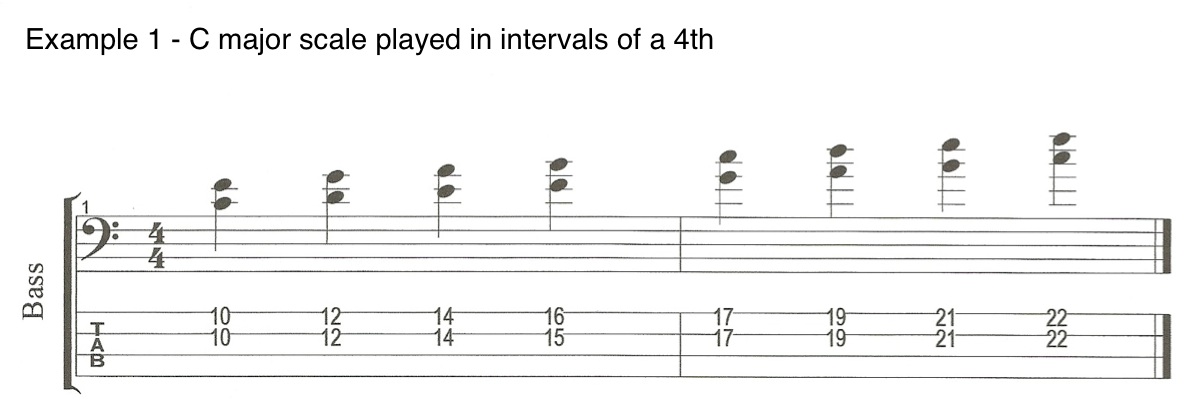What Are Intervals and How Do You Play Them On a Bass?
The word “interval” describes the distance (in terms of pitch) between two musical notes. The smallest interval on the fretboard is a semi-tone. It’s the distance between any note and a note that is one fret above or below on the same string. There are 12 notes in an octave which means there are 12 semi-tone intervals. If we play these 12 semi-tone intervals one after the other then we are playing the “Chromatic Scale”. This isn’t a very interesting sounding scale but it’s really important to understand the chromatic scale if we’re going to understand intervals.
One octave chromatic scale starting and finishing on C
 Because there are 12 semi-tones in an octave, it is possible to play 12 different intervals within an octave (including the interval of an octave itself). Here is a list of all 12 intervals (plus 4 more intervals that are larger than an octave) along with tab showing how to play them on the bass.
Because there are 12 semi-tones in an octave, it is possible to play 12 different intervals within an octave (including the interval of an octave itself). Here is a list of all 12 intervals (plus 4 more intervals that are larger than an octave) along with tab showing how to play them on the bass.
The interval called a “tone” is equal to two semi-tones or you can think of it as the distance of two frets on a single string. Tones and semi-tones can also be called whole-tones and half-tones and also whole-steps and half-steps.
Thirds
An interval of three semi-tones is a minor 3rd and four semi-tones is a major 3rd. Check out Playing Chords on the Bass – Part 1 where I show you how to make chords by using intervals of major and minor 3rd’s to harmonise scales.
Fourths, Fifths and Sixths
Five semi-tones gives us an interval of a 4th. A 4th is neither major nor minor. This interval is often described as a perfect 4th. Six semi-tones gives us an interval called a sharpened 4th because it’s one semi-tone bigger than a 4th. The same interval can be called a flattened 5th because it’s one semi-tone smaller than a 5th. It’s also sometimes called a tri-tone because six semi-tones is equal to three tones. Seven semi-tones makes a 5th or a perfect 5th. Eight semi-tones creates a minor 6th and nine semi-tones, a major sixth. Check out Playing Chords on the Bass – Part 2 where I use intervals of 4th’s, 5th’s and 6th’s to harmonise scales.
Seventh intervals and larger
Ten semi-tones make an interval called a minor 7th. Eleven semi-tones is a major 7th and twelve semitones is an octave. It’s important to note that after the octave the intervals start to repeat the same notes. However, we do still have different names for intervals above an octave. For example, a flattened 9th interval will give you the same note as a semi-tone. A natural 9th interval will give you the same note as a tone. A minor 10th interval is effectively the same as a minor 3rd and a major 10th is the same as a major 3rd








